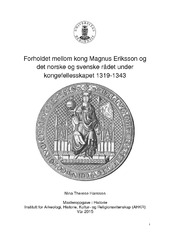| dc.contributor.author | Hansson, Nina Therese | eng |
| dc.date.accessioned | 2015-06-16T07:36:48Z | |
| dc.date.available | 2015-06-16T07:36:48Z | |
| dc.date.issued | 2015-05-14 | |
| dc.date.submitted | 2015-05-14 | eng |
| dc.identifier.uri | https://hdl.handle.net/1956/9979 | |
| dc.description.abstract | Oppgaven er en komparativ studie av forskjellene mellom det norske og det svenske rådets hovedfunksjon i forhold til kongemakten fra 1319-1343. Oppgaven har to hovedmål. Det første målet har vært å undersøke om de to rådenes hovedfunksjon var forskjellig og hvordan de utviklet seg under personalunionen mellom Norge og Sverige. Det andre målet har vært å undersøke hvordan forskjellene i rådenes hovedfunksjon påvirket hvordan Magnus regjerte som konge i de to landene. Ved å se på hvordan rådenes forskjellige hovedfunksjon påvirket Magnus' styre, har oppgaven også kastet nytt lys på debatten om hvem som initierte unionsoppløsningen i 1343. Oppgaven har tre hovedresultater. Det første funnet er at det norske rådets hovedfunksjon var å støtte (sanksjonere) kongen, mens det svenske rådets hovedfunksjon var å begrense den. Kongemakten i Norge hadde flere rettigheter enn kongemakten i Sverige gjennom landenes lover, og det svenske aristokratiet var mye sterkere enn det norske. Rådenes hovedfunksjoner endres ikke under Magnus' umyndighetstid og var fortsatt gjeldende da Magnus ble myndig (1331 i Sverige og 1332 i Norge. Det andre funnet er at den tradisjonelt sterke norske kongemakten og det norske rådets sanksjonerende funksjon førte til at Magnus utferdiget rettarbøter og lover som gav kongen lignende rettigheter i Sverige. Ettersom hans posisjon på den norske tronen var tryggere i Norge enn i Sverige, tilbrakte han mesteparten av sin tid i Sverige for å styrke kongemakten og sikre dynastiet der. Han lykkes i å styrke den svenske kongemakten, og innen unionsoppløsningen i 1343 kan det sies at det svenske rådet hadde fått en sanksjonerende funksjon. Hans fokus på å sikre kongelige interesser i Sverige førte også til misnøye med Magnus og unionen fra det norske rådet fordi han tilbrakte lite tid i Norge. Det tredje funnet er at måten Magnus valgte å regjere som følge av rådenes forskjellige hovedfunksjon, førte til traktaten fra 1343 som bestemte at unionen skulle oppløses. Gjennom å tildele sine to sønner hvert sitt rike ønsket han å forhindre en ny brødrestrid i Sverige. Gjennom ordningen tok han også hånd om misnøyen med unionen i Norge. | en_US |
| dc.description.abstract | This thesis is a comparative study of the difference in the Norwegian and Swedish councils' main function in relation to the monarchy from the start of the union in 1319, till the dissolution treaty in 1343. This thesis has two main objectives. The first goal has been to determine whether the two councils' main functions were different and how they developed throughout the union, and the second goal has been seeing how the differences in the councils' main function influenced how Magnus chose to rule each country. By seeing how the differences in the councils' main function influenced Magnus's rule, this thesis has also shed new light on the discussion of who instigated the dissolution of the union in 1343. There are three main results. The first significant finding is that the Norwegian council's main function was to support the king whilst the Swedish council's main function was to limit the king. Additionally the Norwegian king had more rights than the Swedish king through the countries' laws, and the Swedish aristocracy was much more powerful than the Norwegian one. The councils' main functions remain unchanged until Magnus ascends the throne in 1331 in Sweden and 1332 in Norway. The second finding is that the traditionally strong royal power and sanctioning council in Norway led Magnus to implement statutes and laws that gave the king similar rights in Sweden. As his position on the throne in Norway was much safer than in Sweden, he spent the majority of his reign in Sweden to strengthen and secure the monarchy there. He successfully managed to strengthen the monarchy in Sweden and by 1343 it can be said that the Swedish council had gained a sanctioning function in relation to the king. The third finding is that the way Magnus chose to rule as king because of the differences in the councils' main function led to the dissolution of the union. His intention by making his two sons the heir to one kingdom each was to prevent that factions within the Swedish councils could form under the younger brother if they were dissatisfied with the older brother's rule. By focusing his reign on securing the monarchy in Sweden, the Norwegian council felt that Magnus neglected his duties as Norwegian king. Because of their dissatisfaction they did not object to taking Magnus's youngest son as king, even though that went against their hereditary laws. | en_US |
| dc.format.extent | 1003238 bytes | eng |
| dc.format.mimetype | application/pdf | eng |
| dc.language.iso | nob | eng |
| dc.publisher | The University of Bergen | eng |
| dc.rights | Copyright the author. All rights reserved | eng |
| dc.subject | Magnus Eriksson | eng |
| dc.subject | kongefellesskapet | eng |
| dc.subject | personalunion | eng |
| dc.subject | 1300-tallet | eng |
| dc.subject | union | eng |
| dc.subject | Norge | eng |
| dc.subject | Sverige | eng |
| dc.subject | senmiddelalder | eng |
| dc.subject | råd | eng |
| dc.title | Forholdet mellom kong Magnus Eriksson og det norske og svenske rådet under kongefellesskapet 1319-1343 | eng |
| dc.type | Master thesis | |
| dc.description.degree | Master i Historie | |
| dc.description.localcode | MAHF-HIS | |
| dc.description.localcode | HIS350 | |
| dc.subject.nus | 713107 | eng |
| fs.subjectcode | HIS350 | |
